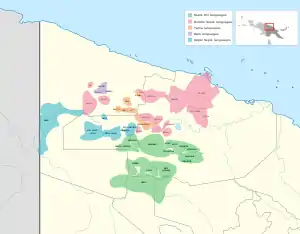Sepik Hill languages
The Sepik Hill languages form the largest and most ramified branch of the Sepik languages of northern Papua New Guinea. They are spoken along the southern margin of the Sepik floodplain in the foothills of Central Range of south-central East Sepik Province.
| Sepik Hill | |
|---|---|
| Geographic distribution | Sepik Hills, south-central East Sepik Province, in the Sepik River basin of Papua New Guinea |
| Linguistic classification | Sepik
|
| Glottolog | sepi1258 |
 The Sepik languages as classified by Foley (2018). The Sepik Hill languages are in green. | |
Languages
The languages according to Usher (2020) are,[1]
- Sepik Hills
- Saniyo-Hiyewe
- Southwest Sepik Hills: Niksek (Paka, Gabiano), Piame, Hewa
- Bahinemo–Berinomo
- East Sepik Hills (Alamblak etc.)
The languages according to Foley (2018) are:[2]
- Sepik Hill
- Eastern (Alamblak etc.)
- Central (Bahinemo etc.)
- Western: Saniyo-Hiyewe, Paka (Setiali), Gabiano (Niksek), Piame, Bikaru, Umairof, Hewa
Other than disagreement at to what is a language or a dialect (Glottolog, for example, concludes that the 'Bikaru' language is probably spurious, and doesn't list Umairof at all), the only difference from Usher is in combining Sanio with the Southwest Sepik Hills languages as a Western branch.
Pronouns
Pronouns in Sepik Hill languages:[2]
pronoun Sare Alamblak Saniyo-Hiyewe 1sg an na ane 2sg nɨ ni ne 3sg.m rɨ rər rei 3sg.f sɨ rət 1du nond nə noto-(si) 2du fin nifɨn fene-si 3du fɨ rəf rowe-si 1pl nom nəm nomo 2pl mɨ nikə(m) fene 3pl rom rəm rowe
Vocabulary comparison
The following basic vocabulary words are from Davies & Comrie (1985),[3] Dye et al. (1968),[4] Foley (2005),[5] Macdonald (1973),[6] and various SIL field notes, as cited in the Trans-New Guinea database:[7]
Language Alamblak Bahinemo Berinomo Bisis Kapriman Bikaru Saniyo-Hiyewe head mʌbogath; mɛ̈ƀɨǥatʰ thu tu tɛpi tuʔus toɣo ʔambu; yowidi 'hɔřise tu; worɛ siyaʔi hair tʰɨ'maʀ̌č; tʌmarts; tʰɨ'maʀ̌š thunʌba to towa; tu sowa tuam tuwam nɨmbɨ; yowididise mato towe; tutowe ear yimbɣindang; yɩmbɨǥin'daŋgɨtʰ; yɩmbʌlindangʌm bʌsiya pɛnɛhax wanbatal womblaja haři; waʔaʌ apahɛ; apaniyɛ eye ɲinga; 'ɲiŋgaʀ̥̥̌; ningaw niya niya nika nikha mɨn 'taʔamɨ; tařa nihe; nihɛ nose 'hʰušɨ ɨtʰ; khusɩmʌth; 'kʰučɨmɨtʰ; kusm sɛkʌnɩ ɛrɛm sikʌľap̶ar singova taʔama; towi ɛrɛme; ɛrɛmɛ tooth bɩ'čɛ̈tʰ; biʃə; bɩ'šɛ̈tʰ; bɩsʌm pi pi binikam bim ne; nɨmbi pi tongue tor; torkh; 'tʰoʀ̥̌tʰ thɔlu tor toguʌl thʌdɩs ketasi; tɨgalɨ sořowɛ; soruwɛ leg wʌlat; 'wɷ'řatʰ; wura lowa rowa hɛna wɛlis wola lowe; rowɛ louse nəm; 'nɛ̈mɨtʰ; nʌmo nʌmu tu nɛm ninis nʌmɩs aƀʌkʰ; lema nɛmɛ dog yauʀ̥̌ʸ; yawi; yawu yo yao yau yom waʔšɨ; waʔšʌ; wina yo; you pig 'ᵽɛ̈gɨʀ̥̌; fagʌr; fəɣ fa hɛ p̶oʔol fʌɣr fe bird nongwar; 'nugwaʀ̥̌ wabo uro nuŋgař yerɛpm heka; namʷio; waʔaƀi iřowɛ; iruwɛ egg fɣa; fokam; ᵽo'ǥat wabo mu uro wɛka nuŋgwawobom yuɣwar heře akia; mbandung hotɛ blood khukhupam; kɨ'kʰupʰam mahələ marɛ hax kukwem kokwem gugubase fisa'i; fisaʔi bone thʌphim; tɨ'pɩʀ̥̌; tɨpi hʌbi sɛtsɛpi sɩbɩkʰam sibevam hɔři paʔaře; pa'arɛ skin tʰɨ'ǥatʰ; thʌkhath thʌbi tepi tibi thʌgas ha'baisi; nbangɨ tahɛ breast mingam; miŋatʰ; niŋgam mosu mok minika mʌnikha ařu'se:; muña mo'u; moʔu tree mᵼč; mim; mᵼš; mɨy mi mɛ mom mə mi; sia me; mɛ man yima; 'yi'maʀ̥̌ 'ɩma muwɛ pɛhɛnɛ nimař wiyak ntu; wɔbi mɛni; mitaru woman 'metɨtʰ7; metum swani mesan toʔanʌs toɣwan taʔagwa; wita taunɛ; tawnɛ sun mar; 'mařɨʀ̥̌ tɩniya teniya maľɛľɛl yɛneza ñʌ; yaki poɔyuɛ; poweyɛ moon yam; 'yamɨtʰ; yamʌth yamal nop yaguso yagos babume; mpaʔopmu yamɛ; yamɛ' water bukbam; 'bupʰam; bu-pam hagi saʔ sagim sagim eipa; ngu sa'i; saʔi fire kaɣ; kʰaǥɨtʰ; khaxth ya itai yoʔoy moyos ʔiya; sea yɛhɛ stone š; taxim ba pa obak obar hana; tumbu tapiyɛ road, path yɨ'ǥotʸoǥatʰ yo ʔatʰoř yaʔambu; yəřo; yəto name 'yuƀatʰ; yufa; yufat wufa wiyapa ovas yapɛ eat fa; ka; 'kʰaɛ̈ʀ̥̌; weyanum; ye diyaw bʌľia̠s asoliya ʔagʌnʌ aiyei; asiyʌ one rɛphar; rpa; řɨpʰatʰ dʌbatha tɛpa tabak dɩbar kɨtʌkʰ; yoko habia hɛta'i; taʔi two hutsif; xočiᵽ; 'xošɩᵽ husi howis wɩtɩp kothi ƀɩtik; yoko labo hɛsi
References
- Sepik Hills, NewGuineaWorld
- Foley, William A. (2018). "The Languages of the Sepik-Ramu Basin and Environs". In Palmer, Bill (ed.). The Languages and Linguistics of the New Guinea Area: A Comprehensive Guide. The World of Linguistics. 4. Berlin: De Gruyter Mouton. pp. 197–432. ISBN 978-3-11-028642-7.
- Davies, J. and Comrie, B. "A linguistic survey of the Upper Yuat". In Adams, K., Lauck, L., Miedema, J., Welling, F., Stokhof, W., Flassy, D., Oguri, H., Collier, K., Gregerson, K., Phinnemore, T., Scorza, D., Davies, J., Comrie, B. and Abbott, S. editors, Papers in New Guinea Linguistics No. 22. A-63:275-312. Pacific Linguistics, The Australian National University, 1985. doi:10.15144/PL-A63.275
- Dye W., Townsend, P., & Townsend, W. 1968. The Sepik Hill Languages: A preliminary report. Oceania 39: 146-156.
- Foley, W.A. "Linguistic prehistory in the Sepik-Ramu basin". In Pawley, A., Attenborough, R., Golson, J. and Hide, R. editors, Papuan Pasts: Cultural, linguistic and biological histories of Papuan-speaking peoples. PL-572:109-144. Pacific Linguistics, The Australian National University, 2005.
- Macdonald, G.E. "The Teberan Language Family". In Franklin, K. editor, The linguistic situation in the Gulf District and adjacent areas, Papua New Guinea. C-26:111-148. Pacific Linguistics, The Australian National University, 1973. doi:10.15144/PL-C26.111
- Greenhill, Simon (2016). "TransNewGuinea.org - database of the languages of New Guinea". Retrieved 2020-11-05.
- Ross, Malcolm (2005). "Pronouns as a preliminary diagnostic for grouping Papuan languages". In Andrew Pawley; Robert Attenborough; Robin Hide; Jack Golson (eds.). Papuan pasts: cultural, linguistic and biological histories of Papuan-speaking peoples. Canberra: Pacific Linguistics. pp. 15–66. ISBN 0858835622. OCLC 67292782.